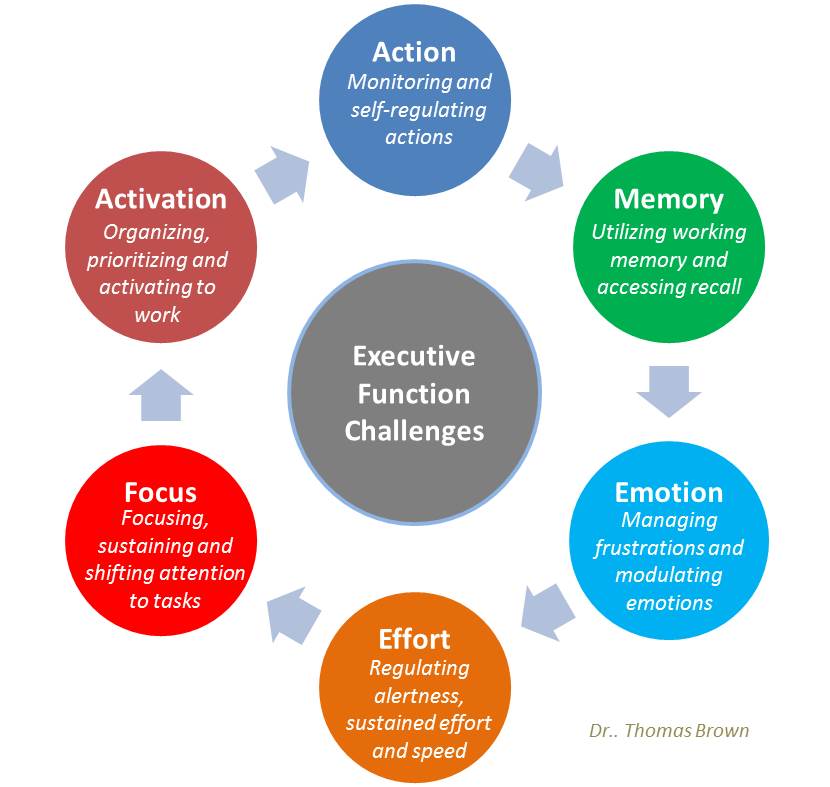What in the World is Executive Functioning? Why Should Parents and Teachers Care?
Here’s one for the messy kid who can never find two matching socks. The kid who says “nothing” when asked what they have to do tonight; who forgets what you asked them to do five seconds ago. The kid whose backpack is stuffed to the gills with wadded up pieces of paper and the remnants of what used to be an amazing art project.
And this is also one for the hyper-organized kid. The one who falls apart if reality does not match the schedule. The kid who bursts into tears when the teachers says “time is up” and maybe even fails to turn in what they deem to be an inferior piece of work. The kid who loses sleep thinking about everything they have to do for the next week and how they can possibly manage to do their best in all of it.
Sound familiar? You are not alone. Almost every parent and educator has faced some version of these tales of child woe at some point or another. And they all come down to executive functioning skills. The good news is that all of these skills are coachable.
You may have heard that term before, but what exactly is executive function?
Defining Executive Function
According to Chicago’s own Rush Neurobehavioral Center (RNBC):
Executive functions are cognitive processes that allow people to plan, organize, make decisions, pay attention, and regulate behavior. All of us use executive function skills to solve problems and evaluate the decisions we make. Research suggests that executive function skills are essential for students to succeed in school and for adults to succeed later in life.
Executive functions, which grow from infancy into adulthood, are controlled by the frontal lobe of the brain. This 18th century “eureka” moment was made possible because of an accident. Poor Phineas Gage, neuroscience’s “most famous patient,” was working on the railroad when an explosion sent a tamping iron straight through his skull. Miraculously, he survived; however, Dr. John Harlow noticed that the injury seemed to have completely altered Gage’s personality. Harlow described him as “fitful, irreverent, indulging at times in the grossest profanity… capricious and vacillating” and “radically changed.” It seemed that Gage had lost all social inhibition and self-regulation. It was also the first evidence in the medical community that the frontal lobes (the injured part of Gage’s brain) control some of our most essential functions—what we now refer to as executive functions.

(Above Left: A daguerreotype portrait of brain-injury survivor Phineas P. Gage, holding the tamping iron which injured him. Above Right: Gage’s skull on display at Harvard Medical School. COLLECTION OF JACK AND BEVERLY WILGUS / WIKIMEDIA COMMONS)
Scientists have since discovered that the frontal lobe is the “conductor” for a great deal of vital human behaviors.

(Image via Headway)
Clinical psychologist, Dr. Thomas Brown, divides frontal lobe brain functions into the following six executive function categories (in no particular order): Activation, Action, Memory, Emotion, Effort, and Focus.

(Image via CogX)
Imagine for a moment, all of the executive function skills we may take for granted, even in the simple task of booking a doctor’s appointment:
Emotion – Allowing oneself to be mindful of how one’s body is feeling; making mind-body connections to know that something is not right.
Activation – Wanting to feel better and making the decision to do something about it.
Action – Taking the step to actually call the doctor and schedule an appointment.
Effort and Focus – Having a well-maintained calendar to know when you are free to book an appointment; understanding that you need to open your calendar to reference during your appointment call.
Emotion – Managing frustration if you have to leave a message, play phone tag, or have to wait weeks for your appointment.
Memory – Being able to recall in comprehensible terms the way your body has been feeling and why you want to see the doctor for treatment; telling your supervisor that you may need to miss work for the appointment; and, of course, remembering to go to the actual appointment!
These are just the functions required before you even see the doctor. Think of all the millions of times we must access these functions within every single day of our lives. Then consider how difficult it must be to do so if those skills are impaired or lacking in strength.
Because these skills are often taken for granted, both child and adult issues with executive function can slip through the cracks. According to RNBC:
Children struggle through the learning process without understanding why. They are sometimes labeled under‐achievers, lazy, or purposely not working up to their potential. Bright children are unable to demonstrate their talents because problems get in the way.
Many children who face social‐emotional learning difficulties also experience problems with Executive Functioning, and learning Executive Function skills can help them to overcome or mitigate the effects of other problems.
Executive Functions Are Teachable:
Just like most muscles in the body, we can exercise and strengthen the executive functions conducted by the frontal lobe.
The neuroplasticity of the human brain— “the changes in brain structure and organization as we experience, learn, and adapt”—allows us the room to constantly improve our habits, thoughts, and behaviors.
Childhood brains are even more “plastic” than the adult brain, making it an ideal time to practice such important everyday functions. The image below from Harvard University Center on the Developing Child shows that, “tests measuring different forms of executive function skills indicate that they begin to develop shortly after birth, with ages 3 to 5 a window of opportunity for dramatic growth in these skills. Development continues throughout adolescence and early adulthood.” [Emphasis ours].

(Via Harvard University Center on the Developing Child)
So What Do We Do?
Bennett Day School, a participant in Rush Neurobehavioral Center’s educator curricula, believes in providing intentional executive function practice for our PreK-12th grade students. Experts in the field believe that the strength of a child’s executive function skills comes down to relationships, supportive activities, and environments—both at home and at school.
Here are a few suggestions on how you can approach each with PK-12th grade children:
Relationships
- Children look to the adults in their lives to model behavior. Name out loud, in front of the child, the executive function steps you are taking when you are engaging in a task together.
- Support their efforts by providing direct praise for a skill used appropriately, i.e. “I noticed that you really thought through and organized what materials we needed to make these cookies before we started. Great planning!”
- Identify, through shared experiences, where the child’s executive function strengths and areas of growth may lie.
- Guide them from dependence on adults to gradual independence by allowing them room to engage in executive functions for themselves and/or the family/classroom.
Activities
Adults in a child’s life (parents, teachers, caregivers, etc.) can and should “provide and support experiences that promote emotional, social, cognitive, and physical development broadly” (RNBC):
- Allow room for “open-ended, creative play” that builds social connections and allows children to organically learn to interact with their surroundings and the boundaries within. This is a major tenet of the Reggio Emilia approach, a progressive philosophy that inspires Bennett Day School’s pedagogy.
- Incorporate mindfulness strategies into home and school routines that can reduce stress in children’s lives. Discuss the source of stress and potential positive coping mechanisms.
- Make time for physical exercise, as it has “been shown to positively affect stress levels, social skills, and brain development”
- Practice makes progress (not perfection). Continue to provide opportunities to practice specific executive function skills with children. Engaging with supportive adults and peers in the process can also reinforce learning.
Environment
- Provide a safe, stable environment. Children who do not feel safe experience prolonged stress and anxiety, which can significantly impair brain development.
- Provide an environment that works with the child’s brain rather than against it. Consider the child’s executive function strengths and challenges—how can you set up their physical environment to aid rather than hinder these functions?
A few examples:
- Deem a spot by the door “the bookbag spot” and practice placing it there every evening/end of the school day.
- Paint a white board wall in the child’s bedroom (or provide a student with a dry-erase planner) where they can plan out their week and also have room for creative expression.
- Create a cubby system in the child’s room (or desk/locker) for storage of their favorite belongings; have them help build the categories for each bin/container and name them something fun.
Every brain is different from the next—as are the ways in which we engage with our executive function skills. With patience and practice, both we and our children/students, can make these vital pieces of our lives even stronger.
To learn more about the executive function coaching services offered by Rush Neurobehavioral Center, click here.
Want to learn how we support executive functioning here at Bennett Day School? Click the link below to sign up for an Info Session & Tour.
{{cta(‘2a1aedaf-87dc-42aa-9ca0-de3854df4d92’)}}